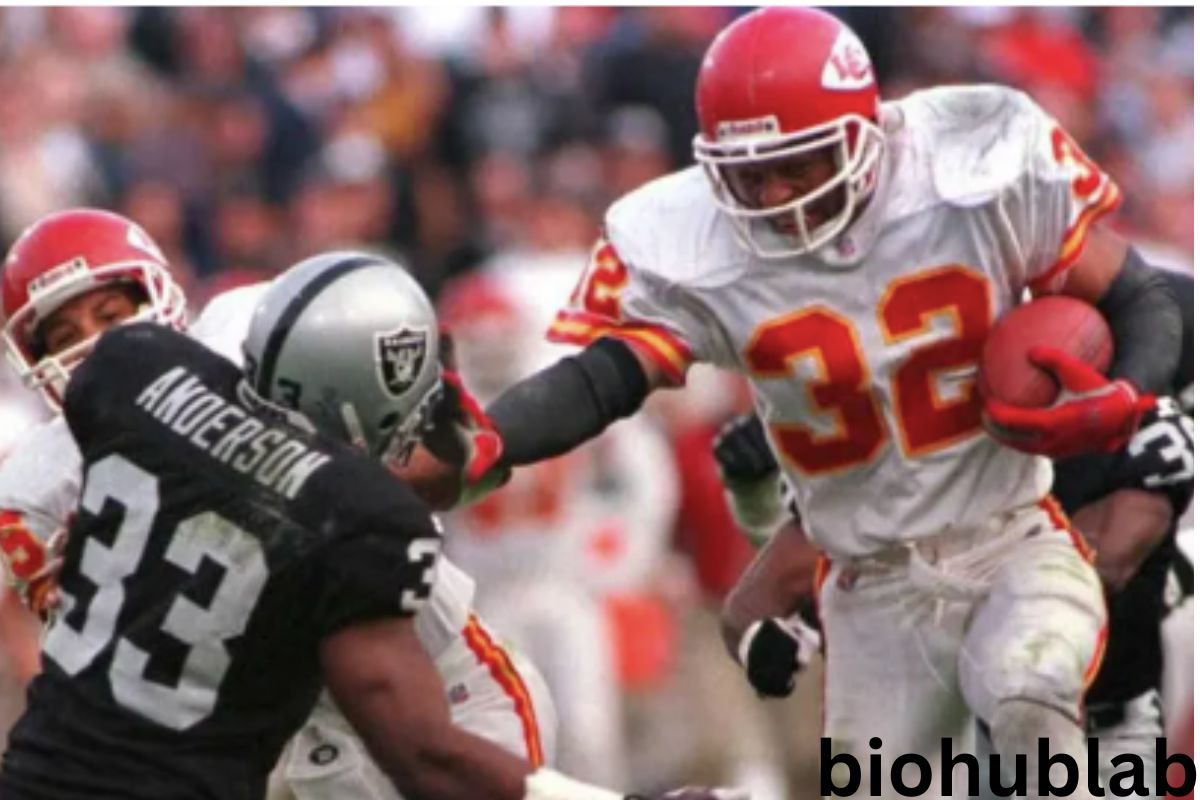Marcus Allen is a name that is respected by many football fans. Allen has an inspiring and impressive journey since his early years in San Diego to his adopted college and NFL. This paper is going to narrate the life of Marcus Allen, including his childhood, college life, career, and post-playing life and legacy. You will also learn statistics, tables and answers to the popular questions concerning him. We shall start with the journey that made this football star.
Who is Marcus Allen?
Allen attended USC in 1978 to 1981. During his first year, he was a participant in a USC team that won a national title. He started as a backup to the star running back Charles White. Allen gained influence and more and more carries over time.
By the time of his junior year (1980), Allen had 1,563 rushing yards and was the national leader in all-purpose yards. His senior season (1981) was a historic one: 2,342 rushing yards and 23 touchdowns, plus other receiving yards. Due to that performance, he was one of the few college athletes to exceed 2,000 yards per season.
Early Life and Background
Childhood in San Diego Marcus Le Marr Allen was born on 26th March, 1960, San Diego, California. Harold “Red” Allen and Gwen Allen were his parents. Marcus was interested in numerous activities and sports when he was growing.
At Abraham Lincoln high school, Allen played in both the offense and the defense. On one occasion, he rushed 195 yards and made five touchdowns in a championship game. He was a state wide player and in 1977 he was named the Cal-Hi Sports Mr. Football as one of the best high school football players in California. These feats helped Allen become a star and preconditioned him in his college career.
Decision to Attend USC
Despite the fact that Allen received some offers of playing defense, he had a dream of playing offense. The University of Southern California (USC) got him an opportunity and he became a member of their program Trojans. Coach John Robinson, a legendary coach, changed Allen to tailback (running back) after he was playing in defense. He was versatile and also an athlete making the transition successful.
College Career and Awards
USC Trojans Performance
Awards and College Level Honors.
In 1981, Allen was a winner in several awards:
Marcus Allen biography table
| Field | Details |
|---|---|
| Full Name | Marcus LeMarr Allen |
| Born | March 26, 1960 – San Diego, California, USA |
| Height / Weight | 6 ft 2 in (1.88 m) / 210 lb (95 kg) |
| College | University of Southern California (USC) |
| NFL Teams | Los Angeles Raiders (1982–1992), Kansas City Chiefs (1993–1997) |
| Position | Running Back |
| Career Span | 1982 – 1997 (16 seasons) |
| Career Stats | 12,243 rushing yards • 5,411 receiving yards • 145 touchdowns |
| Major Awards | Heisman Trophy (1981), Super Bowl XVIII MVP (1984), NFL Offensive Rookie of the Year (1982) |
| Hall of Fame | College (1999), Pro Football (2003), International (2021) |
| Legacy | First NFL player with 10,000+ rushing & 5,000+ receiving yards; dual-threat legend |
Award Year Description
Heisman Trophy 1981 The best player in college football. Maxwell Award 1981 College player of the year award.
Walter Camp Award 1981 Goes to the best collegiate player. Unanimous All-American 1981 Acclaimed by all selectors.
Allen had rushed 4,669 yards, 5,232 yards based on all-purpose plays and had 46 total touchdowns at the end of his college career. These achievements at college level entrenched Allen as one of the best prospects in the NFL.
Professional Career:
Ascent, Achievement, and History. Draft and Early Years with the Raiders. Marcus Allen was picked in the 1982 NFL Draft (the relocating Raiders were based in Los Angeles) in the tenth place. He immediately flashbang, and in 1982, he won the NFL Offensive Rookie of the Year. In the long run, he would be regarded as one of the best goal line and short yardage runners in the league.
One of the highlights was in Super Bowl XVIII when Allen rushed to 191 yards and ran two touchdowns that saw the Raiders win against the Washington Redskins 389). He was named Super Bowl MVP.
Allen had more than 11 seasons with the Raiders and was a regular force. He has rushed thousands of yards, and assisted in the pass game, and was a blocker of the offense.
Subsequent Professional life with Kansas City Chiefs.
Allen later became a free agent in 1993, and joined the Kansas City Chiefs, where he remained visible in the field displaying durability and versatility. During his stay, he won another Pro Bowl (in 1993). He still was a significant offensive and receiving danger. Allen continued to play until 1997 when he retired.
Records and statistics of career.
He was reputed as the first NFL player who had accumulated more than 10,000 rushing and more than 5,000 receiving yards in his career. During his retirement, he was the greatest holder of rushing touchdowns in NFL history (123).
His flexibility was also evident in his death: Allen completed 12 out of 27 career passes with 282 yards and 6 scores.
During playoffs (15 games), he rushed the ball 267 times, had 1,347 yards and 11 rushing TDs; and 52 catches with 522 yards and 2 receiving TDs.
Awards, Recognition, and History.
The greatness of Marcus Allen has been acknowledged throughout:
Pro Football Hall of Fame inductee in 2003.
Earlier inducted in the College Football Hall of Fame.
The International Sports Hall of Fame in 2021.
Known by the Hall of Fame and team pages at Raiders.
Allen is still among the most award-winning football players of all times. His mix of college prizes and business accomplishment is hard to come by. High School State Championship, College National Championship, Heisman, Super Bowl, MVPs, and honors in the hall of fame.
He has also ventured into media and oratory after his playing career where he became a broadcaster at CBS and Fox. He also participated in philanthropic and civic organizations serving as a board member and as a speaker
Playing Style and Strengths
Diversification and Multifunctionality. Marcus Allen was not only a power runner. He would be able to run through the tackles, receive passes out of the backfield, and even throw in some cases.His balance in rushing and receiving skills put a strain of various forms on defenses.
Mastery Goal Line and Short Yardage Mastery.
Allen was reputed to be a great goal line and short-yardage runner. He was hard to bring down around the end zone because of his low centre of gravity and well developed legs. He was the coach who was trusted in 3 rd and goal-line situations by many.
Resistance and Malleability.
Allen played more than 16 seasons, and during this period, he experienced wear, team change, and change of offensive style. He made the transition in his later years of being a featured back to a more complementary one, but he was not inactive. He was flexible as demonstrated by his contribution in receiving and passing and rushing.
His endurance can also be seen in games played and consistency of statistics through a long period.
Difficulties and Objections.
No career is without bumps. In the case of Allen, he had a poor relationship with the owner of Raiders, Al Davis and at other instances, he was at loggerheads with a section of the team management. Allen in his autobiography talks of certain tensions during those days. However, his work on the field would speak more frequently.
Later in his life, he was of course injured as many long-career running backs are. Nonetheless, he changed his style and workload to be efficient.
Impact Beyond the Field
Speaking, Philanthropy and Media. Allen became a broadcaster after ending his career in pro play. He has been associated with NFL Today show of CBS and later Fox Sports to cover college football. In addition to media, he is a speaker, actor, and writer in the publication. He is also a board member, including the Lott Impact Trophy and the Laureus World Sports Academy.
The philanthropic activities and motivational work performed by Allen are indicative that he wanted to give back.
Impact on the Future Generations.
The legacy left by Marcus Allen has been used by the younger running backs, when they felt the need to use both rushing and receiving abilities. Since he was the pioneer in breaking through the statistical categories, he demonstrated how a back did not necessarily have to be one-dimensional.
Marcus Allen vs. Other Legends.
In order to see how Marcus Allen has left his mark in the history of football, we would just have a comparison between him and other greatest running backs and multi-talent backs.
His narrative has been used as a case study of resilience, flexibility and the pinnacle at various levels and spheres; high school, college, to the pros.
Total touchdowns Hall of Fame?
Marcus Allen 12,243 5,411 145 Yes
Barry Sanders 15,269 352 109 Yes
Emmitt Smith 18,355 3,224 175 Yes
Marshall Faulk 12,279 6,875 136 Yes
( These are illustrative comparisons of the numbers of the other players, who are known to be in the top on rushing lists or dual threat lists)
This analysis demonstrates that the dual threat figures of Allen are outstanding among the elite backs. Some backs played more as rushers, but Allen was a combination of several positions.
Recent Mentions and Still Influence
Allen is no longer a player but his name is being mentioned in football media and documentary productions. He appeared in an additional documentary about Heisman winning Hall of Famers in 2023. The Raiders franchise still reminds his legacy by commemorating it in their historical places.
Moreover, his visibility is maintained by the fact that Allen is present in media and talks at conferences.
Summary
The story of Marcus Allen is an excellent, adaptive, and long-term story. His story as a star in high school, an athletic legend at college and one of the NFL stars, is a lesson in its own right:
Creativity is important: Allen demonstrated that it is more effective to be good in many different aspects (rushing, receiving, and some passing).
Fear of pressure: He was asked to do more stuff, his management did, and he was injured, but remained productive in 16 seasons.
Conclusions
Legacy off the field: His media, speaking, and philanthropic work make him continue to influence even off the field.
Statistical leadership: His playing career amounted and documented him as one of the legends whose standards remain to be used by many.
Future generation role model: When players aspire to play a dual threat running back, they tend to emulate the model of Allen.
Marcus Allen is not just a figure of the numbers, he is the story of development, difficulties, and continued success the name that will be remembered in the history of football.
FAQs
1.Who is Marcus Allen?
Marcus Allen is a retired American football running back who had an excellent career in college, at the USC, and his 16-year NFL career, primarily with the Raiders, followed by the Kansas City Chiefs.
2.What were the key records and stats of Marcus Allen?
During his career, Allen was able to amass 12,243 rushing yards, 5,411 receiving yards and 145 total touchdowns. He became the first player to accumulate more than 10,000 rushing and more than 5,000 receiving yards.
3.What are some of the awards of Marcus Allen in the college life?
In college, Allen was the winner of the Heisman Trophy (1981), Maxwell Award (1981), Walter Camp Award (1981) and a unanimous All-American.
4.What was the total number of seasons that Marcus Allen played in the NFL and on what teams?
He played 16 seasons in the NFL. He had a 11-season with the Raiders and a 5-season tenure with the Kansas City Chiefs.
5.And what has Marcus Allen done with his football career?
Allen retired and was engaged in broadcasting on the stations CBS and Fox, became a public speaker, wrote, acted, and engaged in philanthropy. He was also a board member to such projects as the Lott Impact Trophy, and has authored or assisted other projects such as Searching for Angela Shelton.











Leave a Reply